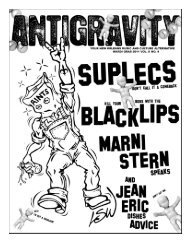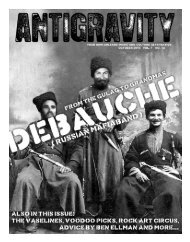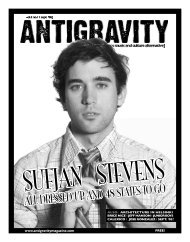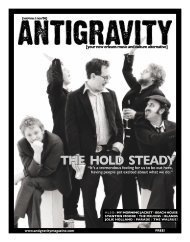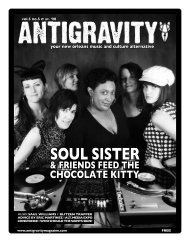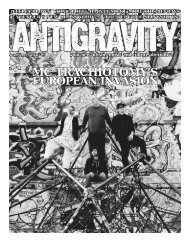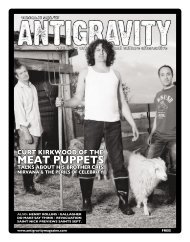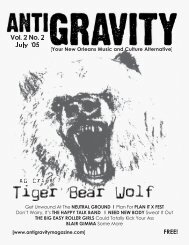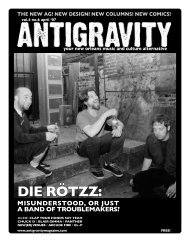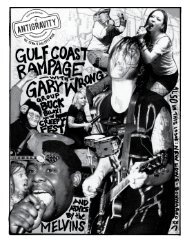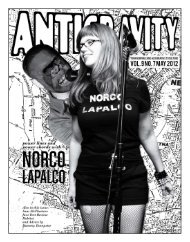January 2007 (PDF) - Antigravity Magazine
January 2007 (PDF) - Antigravity Magazine
January 2007 (PDF) - Antigravity Magazine
- No tags were found...
Create successful ePaper yourself
Turn your PDF publications into a flip-book with our unique Google optimized e-Paper software.
PAGINATIONSIn case you hadn’t noticed,2006 was a banner yearfor Howl. Cashing in on thepoem’s fiftieth anniversary,publishers have given useverything from a newGinsberg biography to a (sort of) star-studded collection ofessays on Howl’s impact to a heap of reissued and/or repackagedwork by the poet. Howl on Trial—published by City Lights,the original publishers of Howl and Other Poems—concentrateson Howl’s long struggle against censorship, beginning with theconfiscation of 520 copies by the collector of Customs onMarch 25, 1957 and continuing through the arrests and trial ofLawrence Ferlinghetti, publisher of City Lights, and ShigeyoshiMurao, a salesman in City Lights Bookshop who was takeninto custody after selling a copy of Howl to undercoverpolice. Though mostly comprised of primary sources—correspondence, trial transcripts, and a section on publicreaction in print media—Howl on Trial also tries to give somehistorical context by way of a short introduction by Ferlinghettihimself, a reprinted essay by ACLU defense lawyer AlbertBendich, and some broader insights on censorship in Americaby Bill Morgan and Nancy J. Peters, the book’s editors.To any fans of Ginsberg’s poetry who might be hoping to find inhere a dramatic courtroom confrontation between the frank andfiery poet and the “horde of middlemen whose fearful allegianceto the Organization of mass stereotype communication preventsthem from sympathy with unconditioned individuality”… well,I’ll just burst your bubble right now. Although he wrote Howl inSan Francisco, Ginsberg spent the time of the book’s publicationand the ensuing trial just about everywhere else, from the ArcticCircle to Paris to Tangiers. Ginsberg’s absence from the trialcertainly casts a shade of unintentional irony over the book’spurpose, but the editors attempt to dispel any doubts we mighthave about Ginsberg’s concern about or involvement in thelegal skirmishes by making the poet’s own correspondenceabout Howl’s publication the first large section of Howl on Trial.While many of these letters tend to get bogged down in thetedium of Howl’s typesetting and binding and a manic discussionof publicity and sales, a few manage to reveal the poet’s rangeof emotions about his groundbreaking new work and its ownautonomous life. In March 1956, still buzzing with the raw,earnest ambition of what he had just created, Ginsberg seemspowered up for battle, “almost ready to tackle the U.S. Govt outof sheer delight.” But by September of the following year, havingwritten very little in the interim, his arrogance has dissolvedinto timidity: “There has been at this point almost embarrassingamount of publicity about ‘Howl.’ I afraid the poem almost tooslight to support the enormous pile of bullshit piles over it—thothat’s probably my own fault.”Correspondence aside, what makes Howl on Trial truly wortha read is the partial transcript of the trial itself. In retrospect,the outcome of the “Battle for Free Expression” seems to havebeen predestined; indeed, the trial itself only intensified thecultural impact of Howl and gave well-known literary figures likeKenneth Rexroth the chance to publicly declare “Howl” to be“the most remarkable single poem published by a young mansince the second war.” The real pleasure to be derived fromreading the trial transcript is in the sheer ridiculousness of thesituation. When the somewhat bumbling prosecutor, DeputyD.A. Ralph McIntosh, asks defense witness Mark Schorer“what ‘andgelheaded hipsters burning for the ancient heavenlyconnection to the starry dynamo in the machinery of night’means,” Schorer coolly responds, “Sir, you can’t translate poetryinto prose; that’s why it’s poetry.” And as McIntosh goes onto quote other sections from “Howl,” the juxtaposition ofhis petty agenda with the poem’s bald, raucous power makesfor an absurdity that Ginsberg himself could have scripted:“‘Adorations! illuminations! religions! the whole boatload ofsensitive bullshit!’ Couldn’t that have been worded some otherway? Do they have to put words like that in there?”But what do the legal tussles over Howl have to do with us,almost a decade after Ginsberg’s death? Just who exactly wereHowl’s opponents, anyway, and has the battleground changedany in the last fifty years? Unfortunately, there’s no dominantnarrative voice in Howl on Trial to lead us directly to the answers.But for the reader willing to navigate through all this materialon her own, some compelling themes do eventually take shape.The notion that censorship itself creates obscenity recurs inGinsberg’s letters and in the trial transcript, as does the viewthat most arguments which seem on the surface to be aboutsexual ‘decency’ in art are usually just about plain old power—be it political power or power within the literary establishment.Maybe what still makes Ginsberg a vital role model for today’sartists and writers is his fiercely literal sense of his own reallifesocial duty in the midst of these struggles. In a letter tothe more traditional poet John Hollander, he writes: “[I]t’s beenthe cowardice and treason and abandonment of the poeticnatural democratic soul by the poets themselves that’s causedthe downfall and doom of the rest of the world too—an awfulresponsibility.”—Liz Countrymanantigravity: your new orleans music and culture alternative_21



